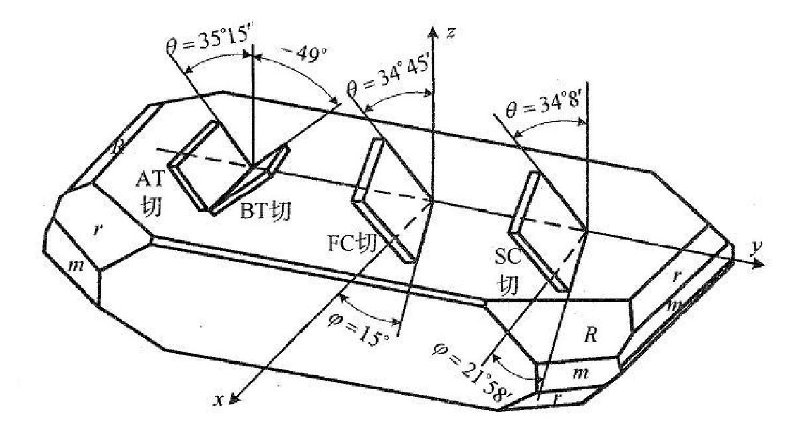Quartz crystal resonator is an electronic device that can be seen everywhere in life. It was born in the early 1920s. Because of its high quality factor and good frequency stability, it is widely used in aerospace, communication, military and other industrial fields.
As the name suggests, the raw material for making quartz crystal resonators is quartz, a very important piezoelectric material. Its main feature is that its atoms or molecules are regularly arranged, which is reflected in the symmetry of the shape on the macro level. Under the action of the electric field, the internal stress of the crystal is generated and deformed, thereby generating mechanical vibration and obtaining a specific frequency. Quartz crystal resonators are manufactured using this inverse piezoelectric effect.
In terms of application, Paul Langevin first explored the application of quartz resonators in sonar during the First World War. Today, quartz resonators are mainly used in various oscillating circuits such as satellite communications, radio and television, computers, telephones, and remote controls to generate clock signals for data processing equipment and provide reference signals for specific systems. An indispensable part of the circuit.
Basic composition of a quartz crystal resonator
The quartz crystal resonator is mainly composed of quartz wafer, base, shell, silver glue, silver and other components. According to the lead condition, it can be divided into two types: in-line (with lead) and surface mount (without lead). The current common main package models are HC-49U, HC-49/S, GLASS, UM-1, UM-4, UM-5 and SMD. The figure below is a quartz oscillator resonator with the outer casing removed, and the inner transparent quartz plate and the metal electrodes plated on it can be seen.
There are three common quartz wafer shapes: round, square, special for SMT or rod type (also square, but smaller). When the orientation is different, its piezoelectric properties, elastic properties and strength properties will be different. The performance of the resonators is also different. The existing cutting methods can be divided into AT-CUT, BT-CUT, CT-CUT, DT-CUT, FT-CUT, XT-CUT, YT-CUT; each cutting method corresponds to an angle, and which cutting method should be used? According to the actual situation, if the temperature characteristics are better, AT-CUT should be used, and if the frequency of the crystal oscillator is higher, BT-CUT should be used. The cutting method, geometry, size, etc. of the wafer determine the frequency of the crystal.

Fabrication of Quartz Crystal Resonator
To produce a quartz crystal resonator with good performance, in addition to a reasonable design and excellent raw materials, the production process will play a decisive role.
Specific steps are as follows:
First, the wools are sorted. Due to the large error of the cutting angle of the quartz wools, the X-ray orientation instrument should be used for angle sorting before rough processing. Then, according to the needs, select the appropriate angle of the hair piece for processing, that is, sticking the strip, cutting the seed crystal, changing the circle, etc.
Then the grinding process is carried out, which is generally divided into coarse grinding, medium grinding and fine grinding. Coarse grinding is mainly to cut the angle and thickness of the wafer, and medium grinding and fine grinding are to make fine thickness adjustment of the wafer.
After grinding, in order to ensure the surface quality of the wafer and the stability and reliability of the crystal during use, the quartz wafer is polished and cleaned. The thicker the wafer, the greater the influence on the vibration performance and resistance of the crystal. Therefore, the deep etching method for removing the loose layer on the surface of the wafer caused by grinding is more effective.
Mounting and dispensing is to slowly put the electrode-plated quartz sheet between the two metal sheets of the belt support, so that the two metal sheets with slot holes tightly clamp the quartz sheet, and then apply the coating on the contact between the electrode and the metal sheet. A layer of conductive glue is applied to make the electrode film contact the metal sheet through the conductive glue on the edge to generate electrical connection.
Frequency modulation is a key process in the production of crystal oscillators, that is, adjusting the resonant frequency of the crystal oscillator to meet the design requirements. For different types of crystal oscillator frequency modulation methods are different, there are methods such as vacuum coating frequency modulation, grinding wafer frequency modulation and so on. For the production of crystal oscillators with small technical added value and relatively high cost requirements, the grinding wafer frequency modulation process is mostly used.
Finally, the shell packaging, printing and finished product measurement processes are carried out.
Summarize
With the continuous expansion of the scale of the information industry and electronic industry in various countries, the application scope of crystal oscillators is still expanding, which drives the continuous growth of its market size. At present, the market has great demand for crystal oscillator products with high precision, high frequency, high stability and low power consumption, and with the development of electronic products in the direction of ultra-thin, miniaturization and functional integration, crystal oscillator products also follow There is still a lot of room for improvement in the production technology of the crystal oscillator industry due to the upgrade to miniaturization, chipization and integration.
